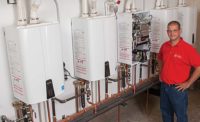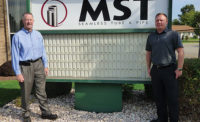In little more than a decade, water heaters have made leaps and bounds in terms of efficiency, installability, usability and connectivity. And with tankless technology increasing in popularity, homeowners have a wide variety of options to choose from.
While some design changes have been driven by the user, others are the result of installer feedback, and recent energy efficiency requirements have certainly left a mark on the industry — especially in regard to storage-type water heaters. But what’s next for this product category?
David Chisholm, vice president of marketing for A. O. Smith’s North American water-heater business, says increases in energy efficiency are the most significant changes in recent years.
“In addition, increased functionality with electronics, enabling diagnostics and ease of use also are key features that have improved,” he says. “Ultimately, driving higher efficiency and enhanced user experiences are a key focus for A. O. Smith.”
Noritz’s products have experienced “significant changes over the last few years to better suit the North American market,” says Sammy Alvarado, marketing assistant at Noritz. He adds these changes were meant to better accommodate installers’ and homeowners’ needs for cost-effective and installer-friendly products — in particular, traditional storage-tank water heaters, which still dominate the market share in the U.S.
Contractor focus
With so many changes affecting water-heating products, manufacturers have recognized they must take steps to ensure installers’ jobs do not become unnecessarily complicated.
“Training the industry in sales, installation and service of Navien products has been the focus of Navien since our beginning,” says Brian Fenske, Navien specialty channel sales manager. “Through Rep Council gatherings and direct involvement in the field with our contractors via site visits, distributor counter days and educational events — along with personalized contractor training — Navien continues to seek their input for product improvements.”
A. O. Smith designs with ease of use and installation in mind, Chisholm says. “We engage a wide range of industry partners throughout our development process. Installability, serviceability and user experience are key considerations to bringing a new technology to market.”
Bradford White Director of Marketing Carl Pinto notes many consumers are starting to look at the energy efficiency of their water heaters much in the way they’ve been looking at their other household appliances the last few decades. “With this increased consumer focus on water-heater performance, manufacturers are looking to improve their current designs and develop new technologies,” he says.
Codes and standards
In April 2015, water heaters experienced an upheaval when the U.S. Department of Energy put into place new energy efficiency mandates requiring higher Energy Factor ratings on virtually all residential gas, electric, oil and tankless gas water heaters. In order to achieve the new efficiency levels, manufacturers had to make some big changes.
“Manufacturers had to add more insulation to the tanks,” Bosch Thermotechnology Senior Trainer Chas Kerin says. “For any given tank-type unit, the overall size becomes significantly larger in order to achieve the required EF rating. This becomes a problem for retrofit situations when a tank-type water heater of the same capacity doesn’t fit in the space where the previous tank was installed.”
The space constraints created by the larger size of tank-type units has contributed to the increasing popularity of tankless units as retrofit replacements for older, less-efficient units. “Many manufacturers bought and rebranded tankless products or joined the market,” Kerin says. “Tankless water heaters represent 10% of the marketplace, and it is a continuously growing segment.”
Chisholm says A. O. Smith is proactively engaging in conversations with DOE and other regulatory bodies on the future of commercial water-heater standards. “We likely will see increased standards for commercial water-heating products in the next few years, and staying on top of these regulatory trends is a key focus,” he says.
Connected water heating
In addition to improvements in efficiency and installability, connectivity also has become a more common feature on new water-heating products. Units now can wirelessly connect to a home’s or building’s WiFi network and provide a plethora of information from diagnostics to temperature output and water usage. Whereas efficiency and installability were influenced by DOE and contractors, respectively, this newer trend of connecting water heaters to the Internet of Things (IoT) is largely driven by the consumer.
“The Internet of Things has exploded in so many industries and now it’s starting to take place in our markets,” Patterson Kelley Director of Marketing & Product Management Ross McCartney says. “While we have seen it starting in the residential markets over the last few years, it is now moving into the commercial water-heating market. People want to know what their equipment is doing and how it is performing. The need for better energy management will drive more equipment to be connected to the IoT so we can keep everything operating at peak performance.”
Potentially, the biggest effect of the IoT on water heaters is in its diagnostic capabilities. “Gaining access to performance data and maintenance needs enables us to better serve our customers and equip our service network to come to the jobsite informed and prepared to address the needs of the customer,” Chisholm says.
Training and education
Manufacturers have made every effort to ensure installation is as easy as possible for contractors, but so many changes taking place in such a short period of time has made training and education more important than ever for manufacturers, distributors and installers.
For example, A. O. Smith’s Contractor Rewards and Wholesale Channel Partners networks enable the manufacturer to correspond directly with its channel partners. It also live-streams training content to a wide audience from its Ashland City, Tenn., studio.
Rheem opened four Innovation Learning Centers in Georgia, Connecticut, Texas and Ontario, Canada, with a fifth one slated to open in California next year. The manufacturer also has hired master plumbers on its staff to support its customers with added training and information.
“Up until now we’ve seen technology be the leading trend for contractor training and there still is definitely a place for things such as webinars and apps,” says John Andrews, Rheem’s director, wholesale sales for its water heating division. “We anticipate a stronger demand for real in-person experiences and we think this only will continue to grow as we keep moving down the path of higher efficiencies and innovative products.”
What’s next?
As for upcoming product advances, Fenske jokes he “can’t divulge our secrets,” though he says commercial acceptance of tankless is a fast-growing trend he is noticing. “Cascading of multiple tankless along with the high modulation available and the endless domestic hot-water flow at a precise temperature has not gone unnoticed,” he says. “Compact, space-saving, off-the-floor design and common venting has been an attractive plus to applying tankless commercially.”
Bradford White’s Pinto sees many positive water-heater trends moving forward.
“We’re confident an uptick in new residential construction will continue to boost demand for new water-heating products,” he says. “A considerable part of this growth is expected to be in multi-housing projects. Given that water-heating preferences by builders vary greatly within the multi-housing arena, manufacturers such as Bradford White — offering a broad range of water-heating technology — should expect to have many opportunities in 2017 and beyond. Also, all indications are replacement market trends will be on par with last year, providing water-heater manufacturers ample opportunities for growth. Many reports suggest this positive trend is expected to continue out through at least 2021.”
Chisholm says energy efficiency will continue to be a major trend going forward, as will end-user functionality and user-friendly features. He adds that he and others at A. O. Smith have noticed much more involvement and interest from the end user in recent years.
“Our ultimate goal is to add value to our customers and to provide solutions that are preferred by our channel partners,” he says. “Providing our expertise will be a key factor for our channel partners in the years to come.”
This article was originally titled “Changes for the better” in the October 2017 print edition of Supply House Times.









